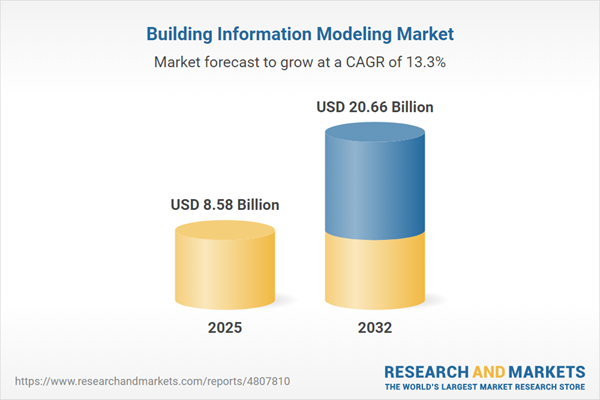Speak directly to the analyst to clarify any post sales queries you may have.
Building Information Modeling (BIM) is increasingly pivotal for organizations navigating the evolving landscape of digital construction and infrastructure delivery. As pressure mounts to align projects with tighter timelines, higher quality expectations, and heightened sustainability goals, BIM adoption is transforming the way stakeholders collaborate—from initial planning through long-term asset management.
Market Snapshot: Building Information Modeling Market Size and Growth Dynamics
The Building Information Modeling Market grew from USD 7.63 billion in 2024 to USD 8.58 billion in 2025. It is expected to continue expanding at a CAGR of 13.25%, reaching USD 20.66 billion by 2032. This growth reflects escalating demand for advanced construction methodologies, rising complexity in global infrastructure, and the strategic push towards data-driven project delivery. The market’s trajectory is underpinned by technology convergence, increasing cloud deployments, and regulatory encouragement in multiple regions.
Scope & Segmentation of the Building Information Modeling Market
- Component Types: Service providers focus on consulting, advisory, implementation, system integration, support, maintenance, training, and certification. Software platforms incorporate analytics, simulation, and mobile collaboration.
- Deployment Modes: Cloud-based—including hybrid, private, and public options—and on-premise solutions serving both flexible and security-focused requirements.
- Project Sizes: Solutions tailored for large, medium, and small projects, with modular and enterprise-grade options suitable for different levels of model complexity.
- Applications: Includes architectural design, collaboration, clash detection, visualization, construction management, cost estimation, energy and sustainability analysis, facility and asset management, mechanical/electrical/plumbing (MEP) engineering, scheduling, and structural design.
- End Users: Architects, civil and structural engineers, contractors, facility managers, surveyors, and BIM coordinators drive adoption across planning and operational phases.
- Regional Coverage:
- Americas: United States, Canada, Mexico, Brazil, Argentina, Chile, Colombia, Peru
- Europe, Middle East & Africa: United Kingdom, Germany, France, Russia, Italy, Spain, Netherlands, Sweden, Poland, Switzerland, United Arab Emirates, Saudi Arabia, Qatar, Turkey, Israel, South Africa, Nigeria, Egypt, Kenya
- Asia-Pacific: China, India, Japan, Australia, South Korea, Indonesia, Thailand, Malaysia, Singapore, Taiwan
- Key Companies Analyzed: A representative sample includes Autodesk, Bentley Systems, 4M S.A., Accruent, Dassault Systèmes, Hexagon AB, Nemetschek SE, Siemens AG, Trimble, and Procore Technologies, among others—covering a spectrum of technology, service, and integration specialists.
Primary Keyword: Building Information Modeling
Key Takeaways for Senior Decision-Makers
- BIM integration delivers value through enhanced collaboration, reduced rework, and better alignment of multi-disciplinary teams across project phases.
- Convergence of digital twins, augmented reality, and IoT has extended BIM’s utility beyond traditional modeling, enabling richer insights for operational efficiency and sustainability.
- Cloud and hybrid deployment models provide scalability and resilience, making advanced capabilities accessible to diverse organizational sizes and geographies.
- Regulatory bodies encourage data interoperability, facilitating smoother collaboration between stakeholders using disparate platforms.
- Strategic partnerships among software vendors, hardware firms, and consultancies are driving innovation while supporting highly tailored, end-to-end solutions for complex builds.
- Specialized training, upskilling, and change management initiatives are proving essential to maximize BIM’s return on investment in increasingly competitive markets.
Tariff Impact and Supply Chain Dynamics
Recent tariff measures in the United States have affected global BIM supply chains, raising costs for imported hardware and software. Organizations reliant on specialized equipment or proprietary platforms are adopting new sourcing strategies, accelerating shifts to cloud-based architectures, and renegotiating service agreements. Small and mid-sized firms are exploring open-source options and regionally oriented solutions to contain costs—resulting in a more segmented supplier landscape and diversified procurement patterns. Vendors are responding with region-specific pricing and localized service delivery to build resilience against ongoing regulatory and economic volatility.
Methodology & Data Sources
The research process combined secondary data from industry journals, regulatory documents, case studies, and vendor disclosures with primary interviews across executive, engineering, and operational roles in key regions. Qualitative and quantitative insights were cross-referenced and validated through triangulation. Additional scenario analysis and expert panel reviews contributed to the robust assessment of trends, competitive positioning, and risk scenarios.
Why This Report Matters
- Delivers actionable intelligence to support digital transformation planning and effective scaling of modern construction workflows.
- Enables benchmarking of technology, deployment, and partnership strategies for greater competitiveness and risk mitigation amid evolving global dynamics.
- Equips senior decision-makers with segmentation and regional insight to optimize investments and project outcomes in diverse markets.
Conclusion
BIM is reshaping construction by streamlining collaboration, driving sustainability, and enabling data-centric decision-making. Organizations leveraging these insights can fortify their market position and future-proof their project delivery capabilities.
Additional Product Information:
- Purchase of this report includes 1 year online access with quarterly updates.
- This report can be updated on request. Please contact our Customer Experience team using the Ask a Question widget on our website.
Table of Contents
3. Executive Summary
4. Market Overview
7. Cumulative Impact of Artificial Intelligence 2025
Companies Mentioned
The companies profiled in this Building Information Modeling market report include:- 4M S.A.
- Accruent, LLC
- ArCADiasoft Chudzik sp.j.
- Asite Solutions Limited
- Autodesk, Inc.
- Bentley Systems, Incorporated
- Computer Methods International Corp.
- CYPE Ingenieros, S.A.
- Dassault Systèmes SE
- Graphisoft SE
- Hexagon AB
- ICON-BIM
- Kahua, Inc.
- MagiCAD Group Oy
- NavVis GmbH
- Nemetschek SE
- Newforma, Inc. by Ethos Capital LP
- Oracle Corporation
- Procore Technologies, Inc.
- Revizto, SA
- Schneider Electric
- Trimble Inc.
- Siemens AG
- International Business Machines Corporation
- TÜV Rheinland AG
- Tejjy Inc
Table Information
| Report Attribute | Details |
|---|---|
| No. of Pages | 185 |
| Published | November 2025 |
| Forecast Period | 2025 - 2032 |
| Estimated Market Value ( USD | $ 8.58 Billion |
| Forecasted Market Value ( USD | $ 20.66 Billion |
| Compound Annual Growth Rate | 13.2% |
| Regions Covered | Global |
| No. of Companies Mentioned | 27 |









